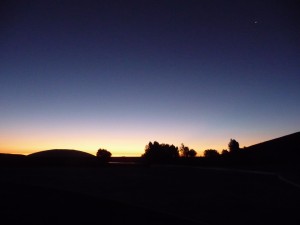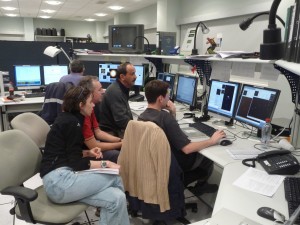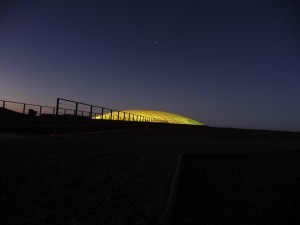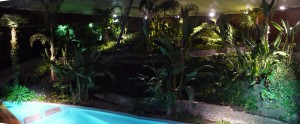X-Shooter goes on sky again (Night 1)

X-Shooter on sky again (Day 2)
January 17, 2009
X-Shooter goes on sky again and again (Nights 2, 3 and 4)
January 19, 2009As we get out of the residencia (probably better known to the public as la perla de las dunas after the last 007 movie) I can feel the excitement in the team. There are a number of technical things we have to verify tonight and we are all looking forward to see X-Shooter at work on sky.

The silouette of the residencia dome (on the left) against the western twilight sky. Venus is clearly visible on the right upper corner of the photo.
The night looks very promising and the inversion layer, which had dissolved during the day, has reformed. This is usually a very good omen. The Atacama desert is a long, narrow strip delimited on one side by the Andes and on the other by the Pacific Ocean. The water coming from the South, the Humboldt Stream, makes the Ocean so cold at this latitude, that all the humidity condenses over it, forming a thick layer (the so called inversion layer) usually placed at an altitude which is much lower than that of Paranal (about 2600 m above the sea level). This, together with the high mountain chain to the East, is why it almost never rains here. During the day the sea of clouds has disappeared, unveiling the sea of water that is usually buried under it. The coast is at about 12 km from Paranal, where the humidity is typically below 15%. The idea that there is so much water not very far from here does not really help you feeling better. But this is also one of the reasons why ESO has decided to place the VLT here and the price one has to pay for such a dry weather is worth the reward she gets in the end. A miner working in northern Chile, whom I met many years ago in Santiago, used to say that the desert is a philosophy. I start to understand what he meant. Read “Las rosas de Atacama”, by Luis Sepulveda. It will help you in getting at least an idea.
We board the big pick-up parked in front of the residencia, marked by a large sign that is difficult to miss: an A4 sheet taped on the windscreen says “X-Shooter Commissioning Team”. In about five minutes we are on the summit and we enter the control building. The UT3 manager has already opened the dome and handed over Melipal to our telescope operator, Duncan Castex, who is going to assist us during the whole week. The opening of the VLT domes is a bit of a small ceremony and visiting astronomers are often brought into the huge enclosures to witness it with their own eyes. Before the dome doors are opened, the telescope is placed almost horizontally, in order to protect the main mirror from dust or other small things that, falling from the top of the building, could damage its delicate surface. When this is done, the big doors open, together with a series of windows placed on the sides of the enclosures. These are actively controlled according to wind speed and direction, so to ensure a smooth air flow through the building, that prevents the formation of turbulence, enemy number one of good image quality. When the dome is fully open, the telescope is safely brought back to zenith and left there in stand-by, waiting for the night to start. To avoid artificial turbulence, during the day the air within the dome is kept at the temperature expected for the beginning of the night (in these days this is around 14 degrees). If this were not the case, the sun would heat up the dome, which would then behave like a chimney when opened at sunset. In fact, during our daytime tests in the dome, we had always to wear our jackets, just to avoid freezing.

Acquisition of GD108 with X-Shooter. After a few offsets, the star is acquired into the slit, indicated by the rectangular box in the center.
While we wait for the end of evening astronomical twilight (that is when the sun is at 18 degrees below the horizon), we start up X-Shooter, which springs back to life with no problem. The two Paolos run some software debugging and Joel, Elena and I get ready to start with the observations. Hans says: “Lads, we are in business!”. This is the blessing we were all waiting for… First of all we will have to verify the atmospheric dispersion correctors and for doing this we will observe a spectrophotometric standard star, designed as GD108. Spectrophotometric standards (specphots for friends) are stars whose intrinsic spectral energy distribution is well known and serve to transform the counts produced by the digital detectors into physical units. GD108 has been selected because it is a hot blue star, with a rather featureless continuum, but also because its UV spectrum has been studied by the International Ultraviolet Explorer satellite. The atmosphere of our planet filters the UV radiation very efficiently, so that below about 300nm almost not photons manage to get through. This wavelength is often indicated as the atmospheric cutoff. If one wants to observe at shorter wavelengths, she has only one solution: going into space. Nevertheless, it is very important to have ground-based instruments that are able to observe down to the atmospheric cutoff. For instance, there are many spectroscopic lines produced by metals in stars in this region. As a matter of fact, there are very few instruments around that can reach this limit with high efficiency. X-Shooter is one of them. This is why, in order to characterize its performance, we have observed GD108. You can watch a short movie showing the acquisition of this object here.
The instrument behaves very well and after the first excitement we can relax and concentrate on the tests. Loooots of them… For tonight no scientific observations are planned. We first need to be sure everything is behaving in the proper way before we move to more exciting tasks. At about three in the morning, a troupe from the ESO outreach starts preparing the set for a live connection with Paris from the UT2 Kueyen console, just next to us. In fact, the opening ceremony for the International Year of Astronomy is going to take place in a couple of hours in Paris. It is just a coincidence, of course (is it?), but it is interesting to be on this side of the ocean on this special occasion. I bring down Paolo & Paolo to the base camp, because tomorrow morning they have to wake up early and work on the software. Hans has left some time ago, saying that he was not made to work at night (he actually added that he pities astronomers, who have to do it ;-). While we will be sleeping he is going to be busy with the hardware.
It is five o’clock when the ceremony starts. Through a satellite video link we can see Tim de Zeew, ESO’s Director General, who is addressing an audience of more than 600 people including a few Nobel Prizes, with his introductory speech. And it is indeed exciting to see Christophe Dumas, head of Science Operations in Paranal, standing a few meters from our console, talking live to the people sitting in Paris about what we are doing here. “Bonjour Paris!”. You can watch the IAY2009 Opening Ceremony here. But if you want to see it as we saw it here in Paranal, click here.
When the video link is over, our night also comes to an end. Elena prepares the configuration files that will produce the daytime calibrations needed to properly reduce the data we have obtained during the night. Fortunately, they will run while we sleep… Joel is writing up a report of the night activities while Duncan is starting the end-of-night procedures. Everything went fine and we now deserve some rest. Coming down from the mountain top I behold the volcano Llullaillaco, neatly appearing against the eastern twilight sky. It is very pleasant to enter the residencia and breath the moisture produced by the tropical vegetation. We’d better get some sleep. Tonight we will be observing again. We plan to go for Eta Carinae and the famous Supernova 1987A. Let’s see how they look like through X-Shooter.
See you at sunset…





1 Comment
most certainly magnificent news of the fact that trapped miners in Chile have currently got access the outside in in excess of 2 months. It now merely seems like a little more time , a week, so to commentors are saying, before they are liberated.